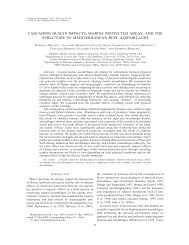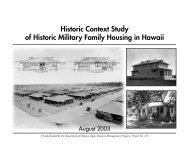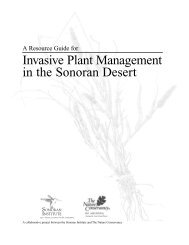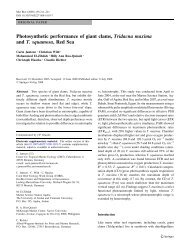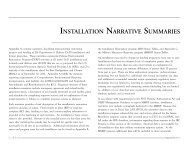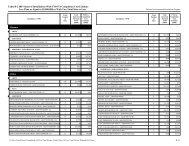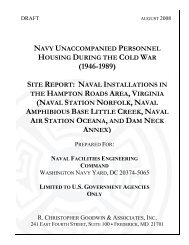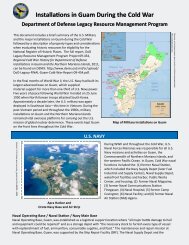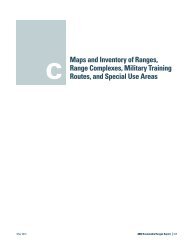Appendix M: Installation Narrative Summaries - denix
Appendix M: Installation Narrative Summaries - denix
Appendix M: Installation Narrative Summaries - denix
Create successful ePaper yourself
Turn your PDF publications into a flip-book with our unique Google optimized e-Paper software.
w��—�2e���2e���������2€�—�� x€v<br />
2ppshX<br />
2ƒ���X<br />
2w������X<br />
2r‚ƒ2ƒ���X<br />
2seq2ƒ�—���X<br />
2g���—���—���X<br />
2w���—2e������X<br />
€�������2„�2h—��<br />
The Milan Army Ammunition Plant (AAP) handles explosive<br />
ordnance. EPA placed the installation on the NPL in July 1987,<br />
and the Army and EPA signed an interagency agreement (IAG)<br />
in 1989. In FY91, the Army discovered the explosive compound<br />
RDX in the City of Milan's municipal water supply wells. In<br />
FY94, the installation formed a Restoration Advisory Board<br />
(RAB). Representatives of the Army, the City of Milan, EPA,<br />
and the State of Tennessee completed a contingency plan to<br />
ensure that safe drinking water would be available to residents.<br />
The city completed a new drinking water well field in 1998 using<br />
funds provided by the Army. The installation completed 5-year<br />
reviews in FY01 and FY05.<br />
Since FY87, preliminary assessments (PAs) and site inspection<br />
(SI) activities conducted at Milan AAP identified 25 sites<br />
requiring further investigation. Subsequent studies expanded<br />
the number of sites to 39. The installation grouped the sites into<br />
five operable units (OUs). To date, the installation has signed<br />
six Records of Decision (RODs), including one in FY92 for OU<br />
1 groundwater treatment plant construction, one in FY93 to<br />
extend a cap over the former O-Line Ponds soil, one in FY00<br />
for the groundwater treatment facility construction at the<br />
Western Boundary Area (OU 4 Region 1), and an interim ROD<br />
for OU 5 in FY04. The cleanup progress at Milan AAP for FY02<br />
through FY05 is detailed below.<br />
In FY02, the Army completed construction and began operation<br />
of a groundwater treatment facility for the Western Boundary<br />
Area (OU 4). The installation completed bioremediation of<br />
explosives-contaminated soil at Lines H and Z, and Areas M<br />
and N. The regulators approved the draft feasibility study (FS)<br />
for overall groundwater contamination. The Army submitted the<br />
draft ROD for OU 4 Regions 2 and 3 to the regulators. The<br />
Army completed remediation of the Y-103 rail classification<br />
yard. The installation continued operation of the OUs 1 and 3<br />
groundwater treatment systems.<br />
In FY03, the installation continued operation of the OUs 1, 3,<br />
and 4 groundwater treatment systems. The composting of Line<br />
X contaminated soil proceeded on schedule. The installation<br />
began two studies for examining groundwater quality. The Army<br />
completed an inventory of the closed, transferred, and<br />
transferring ranges and sites with unexploded ordnance (UXO),<br />
Army<br />
„xRPIQVPHSVPHH<br />
PPDQSU2—���<br />
v�—�D2—����˜��D2�—�D2����D2—��2�������—����2���������2<br />
����—��<br />
SVFISY2��—��2��2x€v2��2t���2IWVU<br />
seq2������2��2IWVW<br />
w��������E���—���2�—����<br />
q������—���2—��2����<br />
2p������2��2h—��X<br />
62ISRFI2�������<br />
2i��F2g„g2@g���2‰�—�AX 62SVFR2�������@p‰2PHPTA<br />
2s‚€Gww‚€2ƒ����2p��—�2‚s€G‚gX p‰2PHHUGp‰2PHIR<br />
2p���E‰�—�2‚�����2ƒ�—���X g��������<br />
discarded military munitions, or munitions constituents. The<br />
inventory identified one closed site totaling 263 acres within the<br />
installation's boundaries where there is possible UXO and<br />
medium explosives safety risk.<br />
In FY04, the Army awarded a performance-based contract for<br />
the <strong>Installation</strong> Restoration Program (IRP) activities at Milan<br />
AAP. The installation signed an interim ROD for OU 5. The<br />
Army selected an interim ROD instead of a final ROD because<br />
it will address groundwater issues in the installationwide<br />
groundwater ROD. The installation continued operation of the<br />
OU 1, 3, and 4 groundwater treatment systems. The Army<br />
conducted pilot studies on the use of carbohydrates to<br />
determine the applicability of these materials to biologically<br />
degrade explosive compounds in groundwater. The installation<br />
completed a PA for the Military Munitions Response Program<br />
(MMRP) site and initiated the SI.<br />
In FY05, the Army completed characterization of all<br />
explosives-contaminated soils within the Northern Industrial<br />
Areas of the facility. Milan AAP began injection of<br />
carbohydrates to determine treatment capability for a<br />
groundwater plume located within the OU 1/OU 2 area. The<br />
installation produced a conceptual site model report to begin<br />
evaluating a remedy for groundwater treatment. The Army<br />
submitted technical memoranda to the regulatory community in<br />
an effort to enhance groundwater treatment facilities<br />
capabilities. In addition, the installation completed a 5-year<br />
review and found no deficiencies. Based on the data generated<br />
during the pilot study within OU 5, the Army was unclear about<br />
whether the use of a carbohydrate for in situ treatment of soils<br />
was appropriate. Due to the low volume of soil exceeding<br />
remedial action (RA) goals, ex situ treatment appeared to be<br />
the most efficient and economical means of treatment. The<br />
Army submitted an SI report for comments for the MMRP sites.<br />
The installation attended partnership training sessions with the<br />
State, EPA, and Army, and established a charter to address<br />
issues that would allow expedited remediation of Milan AAP.<br />
p‰HT2s‚€2€�������<br />
Milan AAP completed soil characterization and excavation for<br />
all production lines. EPA Region 4 indicated some concerns<br />
about whether the installation statistically evaluated its<br />
sampling procedures. Based on review of documentation<br />
provided by the regulators as well as other sources of<br />
information, it appears that the Army can statistically validate<br />
the soils sampling protocols used for determining cleanup. The<br />
installation completed pre-design delineation of all off-site<br />
groundwater plumes. Additional delineation will be required<br />
during the design stage after three groundwater RODs are<br />
completed. The installation also developed and submitted a<br />
draft FS for groundwater to the regulatory community.<br />
Comments were received from EPA and the State of<br />
Tennessee, which identified unresolved issues about RA<br />
objectives and preliminary remedial goals. A Tier II group of<br />
management from EPA Region 4, State of Tennessee, Army<br />
Environmental Center, Corps of Engineers, and installation<br />
restoration personnel was developed to facilitate many of the<br />
groundwater issues that have impeded the approval of the<br />
sitewide groundwater FS.<br />
RAB members toured all groundwater treatment systems and<br />
bioremediation facilities. The RAB co-chair also participated in<br />
discussions about the sitewide groundwater draft FS.<br />
p‰HT2ww‚€2€�������<br />
Milan AAP completed the SI report for the MMRP site.<br />
€�—�2��2e����<br />
Plan of action items for Milan Army Ammunition Plant are<br />
grouped below according to program category.<br />
22222s‚€<br />
0 Complete all excavation of<br />
explosives-contaminated soils in the Northern<br />
Industrial Areas in FY07.<br />
0 Complete FS for sitewide groundwater and RA<br />
for OU 5 soils interim ROD in FY07.<br />
0 Prepare ROD for OUs 1 and 3 groundwater<br />
treatment systems in FY07.<br />
0 Prepare explanation of significant<br />
differences for OU 4 ROD to include Region 2<br />
in FY07.<br />
22222ww‚€<br />
There are no MMRP actions scheduled for FY07 or<br />
FY08.<br />
w��—�D2„��������<br />
M-130




